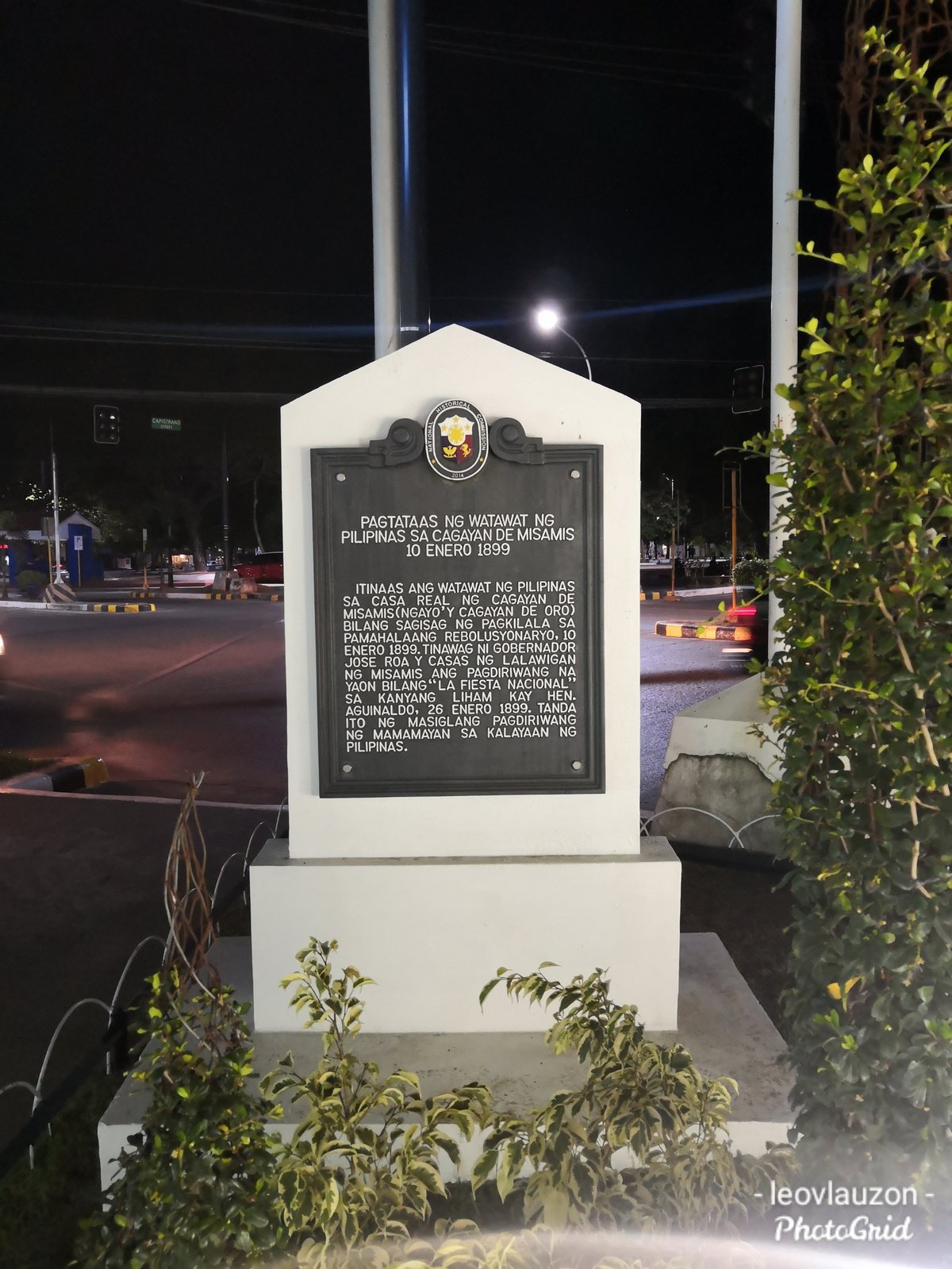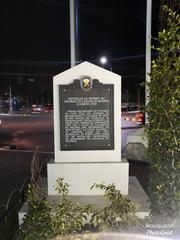
Raising Of The Philippine Flag In Cagayan De Misamis Historical Marker
Complete Guide to Visiting the Raising of the Philippine Flag Historical Marker in Cagayan de Oro
Date: 14/06/2025
Introduction
The Raising of the Philippine Flag in Cagayan de Misamis Historical Marker is a powerful emblem of Mindanao’s participation in the Philippine Revolution and the city’s enduring commitment to national identity. Located in present-day Cagayan de Oro, this site memorializes the historic flag-raising of January 10, 1899—a moment that, while not the first in Mindanao, remains a celebrated act of patriotism and local pride. This guide provides a comprehensive overview for visitors, detailing the historical context, significance, practical information, and suggestions for making the most of your visit (NHCP, SunStar, Evendo).
Table of Contents
- History and Cultural Significance
- Visiting the Marker: Practical Information
- What to Expect at the Site
- Nearby Attractions and Suggested Itineraries
- Community Engagement and Annual Events
- Visitor Tips
- Frequently Asked Questions (FAQ)
- Conclusion
- References
History and Cultural Significance
Mindanao’s Role in the Philippine Revolution
While much of the Philippine Revolution’s history centers on Luzon, Mindanao played a crucial, though sometimes underappreciated, part in the nation’s fight for independence. As Spanish control waned in the late 19th century, revolutionary fervor reached Mindanao, leading to the establishment of local governments aligned with the national revolutionary cause (NHCP).
The Flag-Raising Controversy
Competing Claims
Three Mindanao cities—Surigao, Butuan, and Cagayan de Misamis—each claim to be the site of the first official raising of the Philippine flag in the region. Surigao’s claim is based on the diary of Fr. Alberto Masoliver, S.J., which records the flag-raising on December 26, 1898. Butuan’s is supported by military records and eyewitness accounts citing January 17, 1899. Cagayan de Misamis, however, commemorates its own event on January 10, 1899, when the flag was raised as the city’s revolutionary government was inaugurated (NHCP).
National Historical Commission Deliberation
In the 1998 centennial, the National Historical Institute (now NHCP) convened scholars to resolve the dispute. The panel recognized Surigao as the site of the first official flag-raising in Mindanao, but also acknowledged the historical and patriotic significance of the Cagayan de Misamis event (NHCP).
Importance of the Cagayan de Misamis Event
Despite not being the first, the flag-raising in Cagayan de Misamis is a cornerstone of the city’s historical identity. Led by municipal head Toribio Chaves y Roa, the event marked the formal alignment of the city with the revolutionary government. The act, commemorated by the marker, is a symbol of local heroism and Mindanao’s integral role in the nation’s struggle for sovereignty (SunStar).
Visiting the Marker: Practical Information
Location and Getting There
The marker is located in the Macasandig district of Cagayan de Oro, within a small park area on San Luis Street. The site is easily reached from the city center by either walking (about 800 meters from Macasandig proper) or taking a tricycle, with fares typically between 10–20 pesos (Evendo).
Directions
- Walking: From the center of Macasandig, head toward Macasandig Road, turn onto San Luis Street, and the marker will be on your right.
- Tricycle: Ask for “Pagtataas ng Watawat” and the driver will drop you near the marker.
Opening Hours and Admission
- Hours: The park is open to the public 24 hours a day, though visiting during daylight is recommended.
- Admission: There are no entrance fees or tickets required.
Facilities and Accessibility
- Amenities: The park is modest, with shade from trees and a peaceful atmosphere. Nearby are small stores and eateries.
- Accessibility: The site is accessible for most visitors; however, surfaces may be uneven in places.
What to Expect at the Site
The marker itself is a dignified structure with a commemorative plaque, a flagpole, and interpretive signage. The landscaped surroundings offer a tranquil setting for reflection and photography. The site is a focal point for community ceremonies, especially on National Flag Day and Independence Day, when visitors may witness flag-raising rituals or cultural performances (Evendo).
Nearby Attractions and Suggested Itineraries
Enhance your historical tour by including these sites:
- Saint Augustine Metropolitan Cathedral: Showcases Spanish-era architecture and religious art.
- Gaston Park: A favorite gathering spot with cherry blossoms and fountains.
- Plaza Divisoria: Features the Cry of Freedom Monument and Memorial Wall.
- City Museum of Cagayan de Oro: Offers exhibits on local history and artifacts (AroundCDO).
Combining these with the marker provides a broader perspective on Cagayan de Oro’s heritage.
Community Engagement and Annual Events
The marker is central to local commemorations, including Charter Day (May 28–June 15) and National Flag Day. Events often feature flag retirement ceremonies, poetry readings, and educational programs, helping instill patriotic values and historical awareness (SunStar).
Visitor Tips
- Best Time to Visit: Early mornings or late afternoons offer cooler temperatures and softer light.
- What to Bring: Camera, water, sun protection, and a notebook if you wish to take notes.
- Conduct: Show respect by keeping noise to a minimum, especially during ceremonies. Stand at attention during flag-raising events.
- Photography: Personal photography is welcome; commercial shoots require permission from local authorities.
- Guided Tours: While there are no official tours for the marker, it is included in some broader city heritage walks.
Frequently Asked Questions (FAQ)
Q: What are the visiting hours for the marker?
A: Open 24/7; daylight hours are recommended for safety and the best experience.
Q: Is there an admission fee?
A: No, the site is free and open to the public.
Q: Are guided tours available?
A: The marker is often a stop on heritage walks; check with local tourism offices for schedules.
Q: How do I get there from the city center?
A: Walk or take a tricycle via Macasandig Road to San Luis Street.
Q: What other attractions can I visit nearby?
A: Saint Augustine Cathedral, Gaston Park, Plaza Divisoria, and the City Museum.
Conclusion
The Raising of the Philippine Flag in Cagayan de Misamis Historical Marker is more than a monument—it is a living testament to the sacrifices and patriotism of Mindanao’s revolutionaries. Its accessibility and integration into the local cultural landscape make it an essential stop for anyone interested in Philippine history. By visiting, you not only honor the city’s revolutionary legacy but also connect with the ongoing story of national unity and resilience.
For a deeper experience, combine your visit with other local landmarks and participate in annual commemorative events. Consider using the Audiala app for heritage walks and travel updates, and follow local tourism pages for event schedules and cultural highlights.
References
- National Historical Commission of the Philippines: First and Official Flag Raising in Mindanao
- SunStar Cagayan de Oro: Cagayan de Oro to Mark 75th Charter Day with Flag Retirement, Public Events
- Evendo: Pagtataas ng Watawat sa Cagayan de Misamis Historical Marker
- AroundCDO: Exploring Local Historical Landmarks via CDO Heritage Walk
- Cagayan de Oro City Government: History of Cagayan de Oro City
- Scribd: CDO History Pre Colonial To Modern
- Amazing Butuan: Butuan: Site of First Official Hoisting

